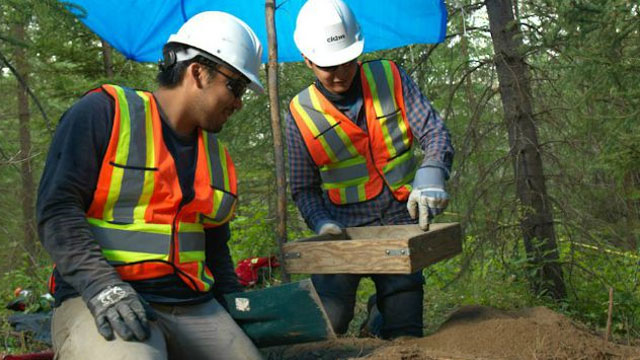Why we take time to learn about berries, bears and birds
Posted by Coastal GasLink
First Nations participants and Hereditary Chiefs insights help us understand, preserve and acknowledge culturally and historically significant areas along the Coastal GasLink route. On any given day, we had as many as 80 First Nations participants alongside us.
At TransCanada, we know that we don’t have all the answers, and others can provide us with important perspectives to help make projects like Coastal GasLink even better. We hear and work to understand the concerns of communities along the route, and ensure we have local involvement in the field work we do, so we have the best available information about the land. We are especially mindful, thoughtful and conscious about the land we are working on, and treat it with great care and respect.
We believe that the best way to complete our field work is with many hands, including those with diverse backgrounds to inform our research. First Nations participants and Hereditary Chiefs in northern B.C. work alongside our environmental scientists to collect immense amounts of data about the land, soils, vegetation, waterways, wildlife and history of this region.
This year, when out doing field work on the Coastal GasLink project, on any given day, we had as many as 80 First Nations participants alongside us. Last year we employed a similar number. Their insights help us understand, preserve and acknowledge culturally and historically significant areas along the route that they respect and value– and so do we. It’s essential these areas are identified, respected and protected, so the project can be designed, constructed and operated in a safe and environmentally responsible way that takes into account their views.
To date, 25 per cent of the over 320,000 hours of field work to date is attributed to local First Nation participants. The information is reviewed by environmental agencies in B.C. and we also share the information with First Nations Chiefs and their community members. That input helps our team evaluate appropriate route options that incorporate the best research and information to avoid or reduce potential environmental effects.
Discoveries we make in the field
When our teams go out to the field to conduct this important work, it could include:
- identifying features like rare plants that need special protection;
- locating and respecting berry patches that are important food and medicinal sources for First Nations;
- examining wildlife migration patterns and habitats, understanding species at risk, and studying nesting birds; and
- our fisheries biologists collecting information about fish species, their habitat, and their habitat types at watercourses along the pipeline corridor, so we can determine the best crossing locations, construction techniques and timing.
What we are looking for out there
Wildlife, fisheries and aquatic studies
We’re also collecting data about fish, mammals, birds and frogs in order to understand their habitats, movements and other patterns to support construction planning and mitigation strategies. TransCanada recognizes water and water systems as a fundamental component of the ecosystems where we operate. The protection of our water resources is of the utmost importance to both the environment and our business.
Vegetation and wetland surveys
This program collects information about the location and seasonal conditions of rare plant populations. Wetland surveys gather further information on varieties of plants, surface water characteristics, soil moisture and nutrient content, soil texture and wetland classification.
Archaeological field program
Coastal GasLink’s archaeological field program helps identify archaeological resources along the project corridor and recommend viable alternatives for avoiding or mitigating any impacts to those resources. Archaeological crews normally include advisors on traditional knowledge from First Nation communities. We have taken this same careful approach on other projects to protect artifacts and other significant resources, and this is the same care and attention we will provide along the proposed Coastal GasLink route.
Engineering field programs
The on-the-ground engineering survey program helps us refine the construction footprint along the pipeline corridor. We have a great respect for the land and its unique characteristics, and our goal is to have as little disturbance as we can to the land, ensure the safety of our workers and allow for the safe operation of construction equipment.
We want to work with local First Nations communities and other communities to plan and build the best possible pipeline that takes into account the various views along the pipeline route. We want to do the right thing – every step of the way.